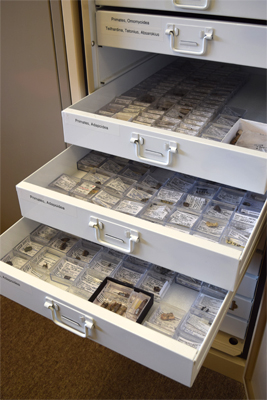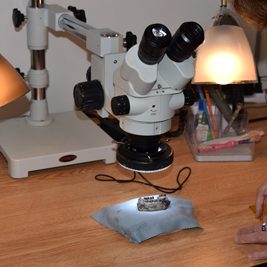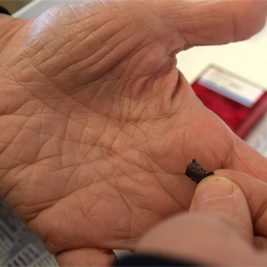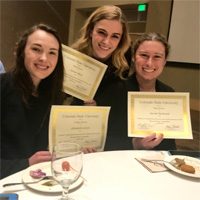The Primate Origins Laboratory provides undergraduate access to supervised independent research experience and training in museum curation methods specific to vertebrate paleontology. The extensive collection of fossil specimens comes from over 100 CSU field localities in the lowest Willwood Formation (56-53 Ma) in the Bighorn Basin, Wyoming. The collection is the product of the ANTH 470 Paleontology Field School and now houses over 4,000 fossil specimens. These include the earliest-confirmed primates (Omomyoidea, Adapoidea) and their allies (Plesiadapiformes), as well as representatives of an additional 24 orders of mammals and other organisms. In total, the collection comprises a sample of a subtropical paleobiome, dating to the earliest Eocene in North America, the warmest period in earth’s history.

• Storage of 4,000+ vertebrate fossil specimens in compliance with Bureau of Land Management (BLM) collecting permit specifications in conjunction with Department of Vertebrate Paleontology, Denver Museum of Nature & Science guidelines and support
• Fossil preparation workspace for students engaged in daily/weekly curation tasks
• Daily collections access for student fossil-specific research projects
• Storage space for lab and field equipment
• Instructional space for ANTH 470 Paleontology Field School course
• Library of publications related to vertebrate paleontology and geology
• Computer access for research
• Space for weekly meeting of lab researchers and preparators with supervisors
• Lab tours for K-12 instructors and students


Equipment & Software
- Omano Boom Microscope, binocular
- Omano Boom Microscope, trinocular with camera
- Dremel and Proxon microtools
- Dynolite imaging device
- Laptop computers, software for Dynolite & Omano trinocular photo imaging
- Air-scribe with compressor
- Photo-stand, Nikon Camera
- Desktop computer with printer
- Seven fossil storage museum cases, property of Denver Museum of Nature & Science
Collections
The extensive collection of fossil specimens comes from over 100 CSU field localities in the lowest Willwood Formation (56-53 Ma) in the Bighorn Basin, Wyoming. The collection is the product of the ANTH 470 Paleontology Field School and now houses over 4,000 fossil specimens. These include the earliest-confirmed primates (Omomyoidea, Adapoidea) and their allies (Plesiadapiformes), as well as representatives of an additional 24 orders of mammals and other organisms. In total, the collection comprises a sample of a subtropical paleobiome, dating to the earliest Eocene in North America, the warmest period in earth’s history.
Students Working in the Primate Origins Lab
Fall 2019
10-15 Paleontology Field School (ANTH 470) students & teaching assistants each year
15-18 Preparators per year
(Includes Independent Study)
10-12 Researchers per year
(Includes Independent Study)
Students have used their training in the Primate Origins Lab to obtain volunteer positions at the Denver Museum of Nature & Science, Department of Vertebrate Paleontology. They have also utilized the fossil collection and lab equipment for research projects that have resulted in Senior Capstone projects in Anthropology &/or Honors Programs, annual CURC (Celebrate Undergraduate Research & Creativity) events, and abstract publications for presentations at the annual professional meetings of the Society of Vertebrate Paleontology (SVP) and the Geological Society of America (GSA).

Senior Capstones
- 2018 Ben Rodwell, Elizabeth Larson
- 2017 Lindsey Johnson
- 2016 Hannah Curtis, Courtney Patton, Kaia Renouf
- 2015 Jared Peltzman
- 2014 Lucas Weaver
- 2013 Natalia Clark
CURC Presentations
- 2018 Carson Black, Elizabeth Larson, Kristen Miller
- 2017 Rachel Bockrath, Hannah Curtis, Courtney Patton, Ben Rodwell, Emily Yannarella, Courtney Wilson
- 2016 Kaia Renouf, Ben Rodwell
- 2015 Jared Peltzman, Lucas Weaver
- 2014 Natalia Clark
Professional Meeting Presentations
Rodwell, Ben W. (2018) Dental topographic analysis of dietary adaptations in early Eocene euprimates. Abstract. Society of Vertebrate Paleontology, Annual Meeting, Albuquerque, NM (October 2018).
Larson, Elizabeth B., with A.E. Chew, Kimberly A. Nichols, and Thomas M. Bown (2018) Analysis of unusual abundance occurrences of Hyopsodus (Condylarthra) and Hyracotherium (Perissodactyla) in the lower Eocene Willwood Formation, Bighorn Basin, Wyoming, and resolution for Biohorizon C. Abstract. Society of Vertebrate Paleontology, Annual Meeting, Albuquerque, NM (October 2018).
Rodwell, Ben W. and Kimberly A. Nichols (2017) Dental topographic analysis of dietary adaptations in early Eocene euprimates. Geological Society of America (GSA) Annual Meeting, Seattle, WA, Abstracts with Programs, Vol. 49, No. 6 doi: 10.1130/abs/2017AM-306372
Rodwell, Ben W., with Thomas M. Bown, and Kimberly A. Nichols (2016) Paleosol maturity, mammalian distribution, and microhabitats at Eocene fossil vertebrate localities of the Willwood Formation (lower Eocene), Bighorn Basin, Wyoming. Geological Society of America 2016 Annual Meeting, Abstracts with Programs (Denver, CO). Abstracts with Programs, Paper 162-12. doi: 10.1130/abs/2016AM-279012
Bown, Thomas M., with A.E. Chew, Kimberly A. Nichols, Ken D. Rose, Ben W. Rodwell, and Luke N. Weaver (2016) Paleogene sedimentary tectonics of the Greybull/Basin area, northwest Wyoming: Little Dry Creek Parafold and Gould Butte/Three Sisters Block. Geological Society of America Annual Meeting, Denver, CO. Abstracts with Programs, Paper 347-24. doi: 10.1130/abs/2016AM-277404
Bown, Thomas M., with A.E. Chew, Kimberly A. Nichols, Ken D. Rose, Luke N. Weaver, and Ben W. Rodwell (2016) Using fossil vertebrates to date early Eocene tectonosedimentary activity in the Greybull/Basin area of northwest Wyoming. Journal of Vertebrate Paleontology, abstracts volume, 102. Society of Vertebrate Paleontology Annual Meeting.
Nichols, Kimberly A., with Thomas M. Bown, Natalia M. Clark, and Luke H. Weaver (2015) New, partially articulated skeleton of Palaeanodon (Mammalia: Palaeanodonta) from the Willwood Formation (lower Eocene), Bighorn Basin, Wyoming. Geological Society of America Rocky Mountain Section Annual Meeting (Casper, WYO), Abstracts with Programs, 47(6):12.
Weaver, Luke N., and Kimberly A. Nichols (2015) Lateral and Temporal Distribution of Early Eocene Primates in Relation to Relative Paleosol Maturity, Willwood Formation, Bighorn Basin, WY. Abstract, PaleoBios 32(1):17.
Clark, Natalia M., with Kimberly A. Nichols, Luke N. Weaver, and Thomas M. Bown (2015) Dental-based body mass estimation in early Eocene primates and Plesiadapiformes; Willwood Formation, Bighorn Basin, Wyoming. Geological Society of America Rocky Mountain Section Annual Meeting (Casper, WYO), Abstracts with Programs, 47(6):12.
Bown, Thomas M., with Kimberly A. Nichols, Luke N. Weaver, Natalia M. Clark, and Richard Stucky (2015) Role of lowered baselevels in the generation of early Eocene biohorizons; Willwood Formation, southern Bighorn Basin, Wyoming. Geological Society of America Rocky Mountain Section Annual Meeting, Casper, WY. Abstracts with Programs, 47(6):12.